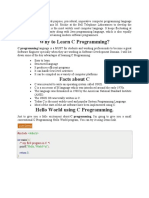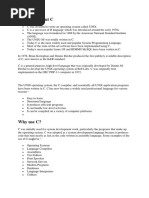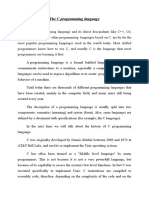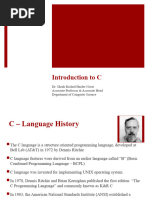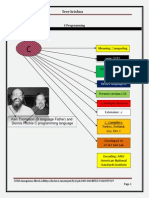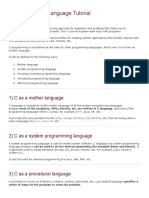0 ratings0% found this document useful (0 votes)
12 viewsLect2 History of C
Lect2 History of C
Uploaded by
Aryan NegiC was developed in 1972 by Dennis Ritchie at Bell Labs to create the UNIX operating system. It is a general-purpose, procedural programming language that is widely used for system programming. C is easy to learn, produces efficient programs, and can be compiled on many platforms. It was used to write UNIX and is still commonly used today for writing operating systems and databases like Linux and MySQL. A basic C program includes preprocessor commands, functions, variables, statements, expressions, and comments like "Hello World" which prints that text.
Copyright:
© All Rights Reserved
Available Formats
Download as PPTX, PDF, TXT or read online from Scribd
Lect2 History of C
Lect2 History of C
Uploaded by
Aryan Negi0 ratings0% found this document useful (0 votes)
12 views6 pagesC was developed in 1972 by Dennis Ritchie at Bell Labs to create the UNIX operating system. It is a general-purpose, procedural programming language that is widely used for system programming. C is easy to learn, produces efficient programs, and can be compiled on many platforms. It was used to write UNIX and is still commonly used today for writing operating systems and databases like Linux and MySQL. A basic C program includes preprocessor commands, functions, variables, statements, expressions, and comments like "Hello World" which prints that text.
Original Description:
Lect2-History-of-C
Original Title
Lect2-History-of-C
Copyright
© © All Rights Reserved
Available Formats
PPTX, PDF, TXT or read online from Scribd
Share this document
Did you find this document useful?
Is this content inappropriate?
C was developed in 1972 by Dennis Ritchie at Bell Labs to create the UNIX operating system. It is a general-purpose, procedural programming language that is widely used for system programming. C is easy to learn, produces efficient programs, and can be compiled on many platforms. It was used to write UNIX and is still commonly used today for writing operating systems and databases like Linux and MySQL. A basic C program includes preprocessor commands, functions, variables, statements, expressions, and comments like "Hello World" which prints that text.
Copyright:
© All Rights Reserved
Available Formats
Download as PPTX, PDF, TXT or read online from Scribd
Download as pptx, pdf, or txt
0 ratings0% found this document useful (0 votes)
12 views6 pagesLect2 History of C
Lect2 History of C
Uploaded by
Aryan NegiC was developed in 1972 by Dennis Ritchie at Bell Labs to create the UNIX operating system. It is a general-purpose, procedural programming language that is widely used for system programming. C is easy to learn, produces efficient programs, and can be compiled on many platforms. It was used to write UNIX and is still commonly used today for writing operating systems and databases like Linux and MySQL. A basic C program includes preprocessor commands, functions, variables, statements, expressions, and comments like "Hello World" which prints that text.
Copyright:
© All Rights Reserved
Available Formats
Download as PPTX, PDF, TXT or read online from Scribd
Download as pptx, pdf, or txt
You are on page 1of 6
History of C language
History of C language
C programming is a general-purpose, procedural, imperative computer programming
language.
It was developed in 1972 by Dennis M. Ritchie at the Bell Telephone Laboratories to develop
the UNIX operating system.
C is the most widely used computer language.
Why to Learn C Programming?
C programming language is a MUST for students and working professionals to
become a great Software Engineer specially when they are working in Software
Development Domain. Following are the key advantages of learning C
Programming:
Easy to learn
Structured language
It produces efficient programs
It can handle low-level activities
It can be compiled on a variety of computer platforms
Facts about C
C was invented to write an operating system called UNIX.
C is a successor of B language which was introduced around the early 1970s.
The language was formalized in 1988 by the American National Standard Institute (ANSI).
The UNIX OS was totally written in C.
Today C is the most widely used and popular System Programming Language.
Most of the state-of-the-art software have been implemented using C.
Today's most popular Linux OS and RDBMS MySQL have been written in C.
Structure of a C Program
Hello World Example
A C program basically consists of the following parts −
Preprocessor Commands
Functions
Variables
Statements & Expressions
Comments
#include <stdio.h>
void main()
{
/* my first program in C */
printf("Hello, World! \n");
}
Thank you
You might also like
- History of C - AryanDocument6 pagesHistory of C - AryanAryan NegiNo ratings yet
- C ProgrammingDocument3 pagesC ProgrammingAditi kokaneNo ratings yet
- 2 C Language OverviewDocument2 pages2 C Language OverviewrashNo ratings yet
- C Programming Is A GeneralDocument2 pagesC Programming Is A GeneralSri Laser ComputerNo ratings yet
- C LanguageDocument2 pagesC Languagetahir777No ratings yet
- Facts About CDocument2 pagesFacts About Calphxn cknNo ratings yet
- C Language - OverviewDocument2 pagesC Language - Overviewajwa telNo ratings yet
- C ProgramsDocument2 pagesC Programsalphxn cknNo ratings yet
- Facts Not About CDocument2 pagesFacts Not About Calphxn cknNo ratings yet
- Facts Not About CDocument2 pagesFacts Not About Calphxn cknNo ratings yet
- Facts Not About CDocument2 pagesFacts Not About Calphxn cknNo ratings yet
- C ProgramsDocument2 pagesC Programsalphxn cknNo ratings yet
- C Quick GuideDocument77 pagesC Quick GuidegsaijanardhanNo ratings yet
- Comprog1 Lesson Proper2Document4 pagesComprog1 Lesson Proper2mariejoypicaNo ratings yet
- Lecture01 C WSDocument7 pagesLecture01 C WSOrinNo ratings yet
- C LanguageDocument80 pagesC Languagezizou1977No ratings yet
- intro to cDocument7 pagesintro to cdivyadharshniravi.sixphraseNo ratings yet
- Programming in C - SCS8C11Document170 pagesProgramming in C - SCS8C11Udaya KumarNo ratings yet
- C Language Programming: AgendaDocument4 pagesC Language Programming: Agendavisualn8No ratings yet
- C Notes by Kumar HarshaDocument41 pagesC Notes by Kumar HarshaKumar Harsha100% (1)
- C-Programming Unit 2Document10 pagesC-Programming Unit 2nabinrajak84No ratings yet
- Assignment of C ProgrammingDocument10 pagesAssignment of C ProgrammingRajneesh SharmaNo ratings yet
- History of C Programming LanguageDocument4 pagesHistory of C Programming LanguageSudhanshu Singh100% (2)
- History of C Programming LanguageDocument6 pagesHistory of C Programming LanguageBHAGYALAXMI JNo ratings yet
- Unit1 ComputersDocument2 pagesUnit1 ComputersRahul KusumaNo ratings yet
- Introduction To C ProgrammingDocument3 pagesIntroduction To C ProgrammingBrajesh KumarNo ratings yet
- C General 1Document1 pageC General 1kok_oc25No ratings yet
- What is C LanguageDocument8 pagesWhat is C Languagesumaramarthi1982No ratings yet
- 01introduction To C ProgrammingDocument35 pages01introduction To C ProgrammingER. MANISHNo ratings yet
- Essay C LanguageDocument4 pagesEssay C LanguageAndrei Smadea0% (1)
- Ch01-Introduction-To-Cprogramming LanguageDocument31 pagesCh01-Introduction-To-Cprogramming LanguagezidragroupNo ratings yet
- I'm Iron ManDocument2 pagesI'm Iron Manankitasahu iciciNo ratings yet
- 1.what Is CDocument1 page1.what Is Ctallyeducation400No ratings yet
- 01 C ProgrammingDocument19 pages01 C Programmingpnkulkarni05No ratings yet
- Lecture-1.1-Introduction To CDocument9 pagesLecture-1.1-Introduction To Cmd.niloy26643No ratings yet
- Lecture-1-Introduction To CDocument9 pagesLecture-1-Introduction To CSaleh Ahmed SifatNo ratings yet
- Overview of C Language and Environment: Topic No. 03Document17 pagesOverview of C Language and Environment: Topic No. 03Charianne Mae Vailoces YanocNo ratings yet
- Electromechanical Engineering Faculty of Engineering Somali National University Course Name: Elementary Programing Concept Course Code: EPC 2309Document11 pagesElectromechanical Engineering Faculty of Engineering Somali National University Course Name: Elementary Programing Concept Course Code: EPC 2309kadar AhmedNo ratings yet
- C Language - OverviewDocument7 pagesC Language - Overviewmichal hanaNo ratings yet
- Importance ofDocument2 pagesImportance ofapoorva_ln4985No ratings yet
- C (Pronounced Like The: Citation NeededDocument1 pageC (Pronounced Like The: Citation NeededMartina KarafiloskaNo ratings yet
- Introduction To CDocument5 pagesIntroduction To Cyimit65788No ratings yet
- C PROGRAMMING 2020 Lesson 1 and 2Document10 pagesC PROGRAMMING 2020 Lesson 1 and 2Legrand Mondo LelionNo ratings yet
- C Quick GuideDocument145 pagesC Quick GuideArif HussainNo ratings yet
- C Programming Session 1Document7 pagesC Programming Session 1Kiran KardileNo ratings yet
- What Is C Programming Langauge?Document11 pagesWhat Is C Programming Langauge?Ali MohammedNo ratings yet
- C ProgrammingDocument174 pagesC ProgrammingAjay Kumar TungalaNo ratings yet
- Unit - I Introduction To CDocument30 pagesUnit - I Introduction To Cpanwarbcaboy2024No ratings yet
- CS1000 Basic Programming: Computing Lab - IIDocument19 pagesCS1000 Basic Programming: Computing Lab - IIPartho BiswasNo ratings yet
- C TutorialDocument5 pagesC Tutorialmichal hanaNo ratings yet
- Cl -7chpt 2 Overview CDocument8 pagesCl -7chpt 2 Overview CSivashankari RajanNo ratings yet
- Case Study-Application Developed in CDocument9 pagesCase Study-Application Developed in CVedang BhangeNo ratings yet
- C Programming HistoryDocument4 pagesC Programming HistorylabviewerfaniNo ratings yet
- Unit1 PCDocument53 pagesUnit1 PCsy312916No ratings yet
- MANUAL Embedded July 2024Document123 pagesMANUAL Embedded July 2024Soumya SephalikaNo ratings yet
- Lesson1 - Introduction To CDocument5 pagesLesson1 - Introduction To CPavan VutukuruNo ratings yet
- C Programming LanguageDocument12 pagesC Programming LanguageGiri RajNo ratings yet
- C LanguageDocument121 pagesC Languageబొమ్మిరెడ్డి రాంబాబుNo ratings yet
- C Programming 1Document17 pagesC Programming 1CarabNo ratings yet

